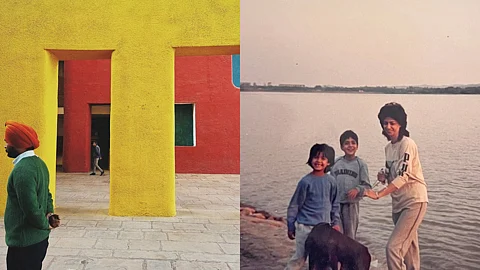
- HOMEGROWN WORLD
- #HGCREATORS
- #HGEXPLORE
- #HGVOICES
- #HGSHOP
- CAREERS
- ABOUT US
- CONTACT US

"Every city has a sex and an age which have nothing to do with demography. Rome is feminine. So is Odessa. London is a teenager, an urchin, and in this hasn’t changed since the time of Dickens. Paris, I believe, is a man in his twenties in love with an older woman."
John Berger
I’ve always interpreted this famous quote by Berger, the renowned English art critic, as him alluding to the fact that each city is unique and possesses a distinct identity. While that is true, I also believe that the city’s identity is ever-fluid and appears differently to different people. It all depends on our ways of seeing. At the same time, if we were to be looking at the cities Berger mentions through his eyes, they may appear to us the way he sees them. Therein lies the beauty of the visual arts.
These were the thoughts swirling around my head when I discovered Chandigarh-based photographer Kismet Jewell Nakai’s body of work. She channelizes her passionate love for her hometown through her craft and emerges as a collector of distinct memories, a diligent archivist, and a transportive storyteller. Her astute powers of observation artfully capture the multifaceted nature of life in Chandigarh — how its diverse inhabitants thrive, how its architecture casts different shadows during different times of the day, how the leaves on the trees change during each season and so much more. Through her lens, I see her hometown Chandigarh as a unique microcosm, reflecting different aspects of human experience, culture, and society.
A unique aspect of Kismet’s oeuvre is her treatment of time. Photographs have the remarkable ability to freeze a fleeting, individual moment. However, she shares with the world not just the photographs of present-day Chandigarh but also photographs of the beautiful city from the yesteryears. Not only that, she often treats her viewers to vintage photographs from her family albums. It is like an intergenerational journey through the building blocks of time as the viewers get to witness her family growing and evolving alongside the city.
In a quick, candid interview with Homegrown, Kismet delved deep into her creative practice.
What initially drew you to capture the essence of Chandigarh through your lens, and how has your relationship with your hometown evolved through your photography journey?
It’s a well known fact that one usually doesn’t appreciate something that is right under their noses until it’s too late or you are far removed from it. Having spent 90% of my life here, it was the same for me - taking for granted the old homes with wide roads and parks full of trees.
I’m not really sure what it was that made me pay closer attention to the city- maybe it was a sense of a lot of change taking place around us, albeit slowly but most definitely happening. The initial plan (and still is) to make a book of the homes of Chandigarh, to forever cement them in time and our memories.
A pivotal point was when I shadowed Manuel Bougot, a well-known Architectural Photographer from Paris, as he photographed Chandigarh for his book, Voyage à Chandigarh. It gave me that push I needed to keep photographing what I could, when I could. As I did, I began to appreciate and understand the city more. I definitely feel more attached to it now then I did when I was younger because back then it was a deadbeat city with nothing to look forward to and now it is a goldmine of architectural delights and urban landscape.
Each of your photographs tells a vivid story. Could you walk us through your creative process, from identifying a subject to capturing, and digging up the archives and selecting a photograph?
My earliest set of photographs are of my own house, which was sold and unfortunately broken down- I photographed all its nooks and crannies and it kind of gives me the benchmark of what to look for and how I would like to photograph different spaces.
Most of the time though, I walk through the Sectors-sometimes systematically, sometimes aimlessly and shoot as I do. Later on while I skim through the photographs, there is almost always a theme to what I have shot sometimes it may be different shapes, shadows, building elements, gates or even the trees in some parks!
I also have a great archive of old photographs dating back to when Chandigarh was built as our families were amongst the first to move here. Photographs that show how it was when my parents went to college when I was growing up, our schools being run from homes and of our old Ambassador and Maruti 800’s. I remember a photograph I know exists in some box or album and I go digging for it!
Your photographs often spark conversations about the socio-cultural fabric of Chandigarh. How do you see your role as a photojournalist and archivist in shaping perceptions and fostering dialogue within your community and beyond?
The main conversation at this point and time is that Chandigarh is changing, as most cities do (which is what I hear a lot) and that we must embrace it, and I agree that a city must change and evolve but how do we preserve it at the same time? If something is unique, do we sit back and watch its destruction or do we find a way to assist its growth but also hold on to its uniqueness at the same time?
I just hope to get people on board this Preservation and Appreciation train. Think about restoring an old home instead of breaking it down, hold on to the beautiful gardens Chandigarh is famous for, walk more in the parks, preserve it physically and let its character evolve along with its people.
Check out her entire body of work centering Chandigarh here.
